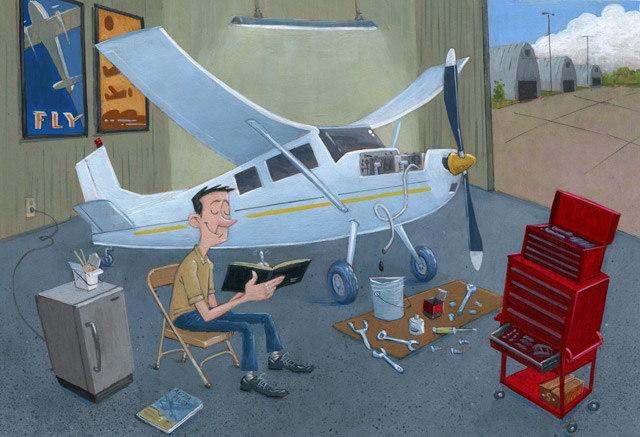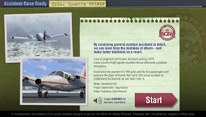What’s in your hangar?
Useful spaces for both the aircraft and the pilot

For more than 25 years, the FAA has taken the position that hangars at federally funded airports should be reserved for aeronautical use. By and large, this has benefitted those seeking to house their aircraft at those airports.
But in recent years—concerned that the FAA’s requirements had become more stringent—some airports’ efforts to create a “sterile” hangar environment have been extreme, forcing hangar owners and lessees to remove every tool, drip pan, spare part, or personal item from their hangars. AOPA and others have complained, and the FAA has responded with an updated policy on hangar use, but AOPA says the proposed update doesn’t go far enough—especially on construction of amateur-built aircraft and privately owned hangars—and is asking the agency to give hangar owners and users more latitude when it comes to how they use the space.
“This is an issue that AOPA has been actively engaged in for many years,” said Greg Pecoraro, AOPA vice president of airports and state advocacy. “The rules for using hangars should meet the common sense test, and we’re going to make sure they do.”
The current battle over what a hangar should hold began in 2009 in Glendale, Arizona. The FAA had been under scrutiny from the Government Accountability Office for inadequate oversight of airport land use, so it was no surprise when the FAA took a hard line in response to flagrant misuse of hangar facilities. Routine investigations into airport land uses resulted in findings that hangars were being used inappropriately. Some local FAA officials and airport managers have responded by trying to clear hangars of any and all nonaeronautical items.
“The FAA’s proposal is a big step in the right direction, but it’s not quite enough,” Pecoraro said. “We know this is important to our members, and we’re filing formal comments and working closely with the FAA and friends in Congress to make sure the new rules reflect the realities of aircraft ownership.”
See the website for more information.
Illustration by John Sauer
Survey: 60% of AOPA members say their airport has fly-friendly procedures.
AOPA Action
Key AOPA comments on hangar policy
• A hangar should be considered to be in aeronautical use if it houses an aircraft that is airworthy or in the process of becoming airworthy (under active construction, repair, or renovation).
• Building an aircraft in a hangar is an aeronautical use from start to finish.
• Owners of private hangars should be allowed greater flexibility, as long as the hangar’s use is primarily aeronautical and any nonaeronautical uses don’t interfere or violate lease agreements, airport minimum standards, or building codes.
• The FAA should acknowledge other aviation activities as legitimate aeronautical uses, including activities and storage related to skydiving, ballooning, and seasonal aircraft needs such as floats, skis, and wheels.
AOPA Advocacy
38%of AOPA members believe lead in aviation gasoline is a very high threat that could lead to more regulations on general aviation.
What aopa is doing to keep you flying: The final four
Unleaded avgas fuels advance
 The FAA announced that four unleaded aviation fuels will undergo initial testing for certification. Two fuels developed by Swift Fuels and one fuel each developed by Shell and Total will undergo testing through late 2015.
The FAA announced that four unleaded aviation fuels will undergo initial testing for certification. Two fuels developed by Swift Fuels and one fuel each developed by Shell and Total will undergo testing through late 2015.
The fuels were submitted through the Piston Aviation Fuels Initiative (PAFI), an industry/government effort to facilitate the development and deployment of a new unleaded avgas to meet the needs of the existing piston-engine fleet. AOPA has been actively engaged in the PAFI steering group from the beginning, along with several other aviation community stakeholders.
“This is an important milestone in the search for a replacement for leaded avgas,” said AOPA President Mark Baker. “We appreciate the collaborative efforts of everyone involved to keep the process moving forward while ensuring the needs of the aviation community are considered at every step along the way.”
Before choosing fuels for testing, the FAA evaluated proposed fuels for impact on the existing fleet, production and distribution infrastructure, environment, toxicological effects, and anticipated aircraft operations cost. Results of this phase will determine which fuels continue to full-scale testing in engines and aircraft. That second phase, due for completion in 2018, will produce data for the certification of one or more fuels.
Congress has appropriated $6 million to fund PAFI in the 2014 fiscal year, and appropriations committees have proposed another $6 million for the following year.
About 167,000 U.S. aircraft and 230,000 worldwide primarily rely on 100 low-lead avgas for safe operation. It is the only remaining transportation fuel in the country that adds tetraethyl lead (TEL) to create the very high octane levels required by high-performance aircraft engines.
Giving back to GA
 AOPA Airport Support Network volunteers across the country are dedicated advocates for general aviation, and it’s no surprise that a lot of them have garnered great respect from their peers through their efforts to keep GA airports and the industry vibrant within their communities.
AOPA Airport Support Network volunteers across the country are dedicated advocates for general aviation, and it’s no surprise that a lot of them have garnered great respect from their peers through their efforts to keep GA airports and the industry vibrant within their communities.
Take Gordon Richardson, who serves as the chairman of the Texas Aviation Advisory Committee, which provides input to TxDOT aviation programs, represents the state on aviation issues, and works with the Texas legislature. Under Richardson’s caring, smart, and respectful leadership the committee is making a difference in GA. Faced with the same challenges as other states across the country, it ensures Texas airports get the support they need. As the ASN volunteer at Caldwell Municipal Airport (RWV) for eight years, Richardson not only works to protect his own airport, but weighs in at other airports as needed. When not serving the state, you can find him looking for adventures in warbirds and seaplanes.
Learn more about what being an ASN volunteer means. Check out the ASI-produced online course, 60 Minutes to Save Your Airport, ASN volunteer orientation online. After you learn, sign up for your airport!
Web: www.aopa.org/asn
AOPA Foundation
 A core tenet of the Air Safety Institute is to help pilots improve their skills and enhance GA safety through free educational programs. AOPA membership dues don’t cover these programs—donations do, but only six percent of AOPA members actually donate to the AOPA Foundation. Whether you’re a member or a friend of GA, please consider contributing today (aopafoundation.org/donate) to support the institute’s important work. Imagine if GA operated on only six percent.
A core tenet of the Air Safety Institute is to help pilots improve their skills and enhance GA safety through free educational programs. AOPA membership dues don’t cover these programs—donations do, but only six percent of AOPA members actually donate to the AOPA Foundation. Whether you’re a member or a friend of GA, please consider contributing today (aopafoundation.org/donate) to support the institute’s important work. Imagine if GA operated on only six percent.
ASI: Dropping temps
 Chill out as ASI tackles winter weather during ‘Ice Week’
Chill out as ASI tackles winter weather during ‘Ice Week’
Before temperatures start to plummet this winter, it would be a good idea to fire up your computer and participate in the Air Safety Institute’s “Ice Week” from October 26 through November 1. Learn how to avoid treacherous icing encounters with ASI’s free resources, including videos, courses, quizzes, accident case studies, and real pilot stories.
Ice Week is brought to you by AOPA Insurance Services and VOYA.
Accept the challenge: Take on ASI’s quiz master
Maybe you fancy flying an airplane that’s bigger, faster, and sexier than the old trainer you’ve come to know so well. But making such a transition requires additional instruction to learn new and often more complex aircraft systems and operating procedures. Is transitioning difficult? Are complex aircraft complicated to fly? Find out with ASI’s Transitioning to High-Performance/Complex Aircraft quiz and challenge your knowledge.
Then test your skills with the quiz- master’s latest brainstorm—Instrument Procedures: A Tale of Two ILSs, which proves that shooting any old ILS to minimums is anything but straightforward at Southern Vermont Regional airport.
New ASI fall seminar: Real World Weather
Visit the web for dates and locations.
See the website for additional brainteasers from Cold Weather Ops to Taming a Twin to Aeromedical Matters and more. Safety quizzes are made possible by AOPA Insurance Services.
Lessons learned
 ‘Cross-Country Crisis’ accident case study
‘Cross-Country Crisis’ accident case study
The pilot and his five passengers were en route from the Chicago area to Raleigh, North Carolina, when the Piper Seneca II encountered deteriorating weather in the mountains near Huntington, West Virginia. As the pilot struggled to maintain control of the aircraft in half-mile visibility and heavy snow, the aircraft also was low on fuel, leaving ATC and the pilot few options.
Using actual ATC audio and dramatic Microsoft Flight Simulator re-creations, Cross-Country Crisis is interspersed with scene analysis on where things went from bad to worse on this ill-fated flight. You’ll come away with safety tips and a clear understanding of how faulty decision-making can paint a pilot into a corner from where there is not much hope of escape. This ASI accident case study highlights the critical and lifesaving role a 180-degree turn can play when pilots encounter deteriorating weather.
See the video.
Products and Services
AOPA Pilot Protection Services: Head in the clouds?
Everyone should know the minimums
By Mike Yodice
ATC does a fine job providing separation and traffic alerts to pilots when and where their capabilities allow it. For the airspace system to function safely and efficiently, however, it’s critical that VFR pilots stay out of the clouds and adhere to certain minimums. FAR 91.155 describes the basic VFR weather minimums, cloud distance, and flight visibility for the different classes of airspace.
The VFR visibility and cloud distance minimums vary depending on the class of airspace and whether it’s day or night. Everyone should know the minimums, but VFR pilots (excluding student, recreational, and sport pilots) operating below 10,000 feet msl can stay compliant in all classes by observing the following basic minimums: Flight visibility—three statute miles; Distance from clouds—500 feet below, 1,000 feet above, and 2,000 feet horizontal.
At times, even IFR pilots need to stay out of the clouds. When flying visual approaches under IFR, pilots must remain clear of clouds. There’s a notable case where an airline captain accepted a visual approach for landing and allegedly flew through a cloud layer reported as a broken ceiling. In that case, the FAA was unable to prove that the pilot flew through clouds, but it did prove he busted cloud clearance minimums required by the carrier’s operating specifications, which mirrored the standard VFR minimums. The FAA suspended the airman’s ATP, but the sanction was waived by the timely filing of a NASA (ASRS) report.
Also, remember the “see and avoid” rule (FAR 91.113), which the weather minimums are meant to support. The rule applies to every one of us; it applies to VFR flights and to IFR operations when weather conditions permit. When VFR operations are conducted in marginal VFR conditions, adherence to see and avoid is challenging.
When VFR operations are conducted in conditions where the cloud clearance and flight visibility are less than minimums, it is unsafe and a clear violation of FAR 91.155. Unless you’re on an IFR clearance, it’s advisable to keep your head—and the airplane—out of the clouds.
Mike Yodice counsels AOPA Pilot Protection Services members on such issues as FAA compliance and enforcement. He is an active pilot and regularly flies a Piper J-3 Cub and Cherokee 180.
80% of AOPA members say they have logged 25 hours or more in the past 12 months.
To learn more about AOPA Pilot Protection Services, visit the website.
 Answers for Pilots
Answers for Pilots
Flying the islands—Plan a trip to paradise
As temperatures drop in most of the United States and we anticipate the arrival of winter, the islands of the Bahamas remain warm and sunny. Are they calling to you?
If you are thinking about taking off for a winter island getaway, read about planning your flight in AOPA’s online Answers for Pilots. And look for additional information on the topic in an upcoming webinar, a short video, and a podcast, brought to you by the Bahamas Ministry of Tourism.
Insurance Services
AOPA Insurance Services is celebrating 20 years of serving the aviation insurance needs of our customers. Visit us online or call 877-622-2672 for information on how AOPA can get you the best deal on aviation and life insurance.
RV–6 owners fly for fun
Airplane partners rely on AOPA insurance
 Ron Waechter owns an RV–6 with two friends, Jerry Foster and Mike Volpp. Now in their second year with AOPA Insurance, Waechter says the partners appreciate “the reasonable pricing, quick response, friendly staff, and the pledge not to penalize coverage of a claim for minor issues.”
Ron Waechter owns an RV–6 with two friends, Jerry Foster and Mike Volpp. Now in their second year with AOPA Insurance, Waechter says the partners appreciate “the reasonable pricing, quick response, friendly staff, and the pledge not to penalize coverage of a claim for minor issues.”
Waechter has been a member of AOPA since he learned to fly in 1978. He considers himself fortunate that his flight instructor back then was a World War II instructor. “I consider myself very fortunate to have learned from such a great aviator,” he says. Today, Waechter has a commercial certificate with multiengine and CFI ratings, but quickly adds, “The only paying flying job I ever had was a patrol job in a Cessna 152.”
Today, the three partners fly for fun and for personal transportation. They attend fly-ins regularly and own other low-and-slow aircraft (Taylorcraft, Cub, Zenith CH 701). “The RV–6 really rounds out the aviation experience,” Waechter says.
This past spring, Waechter and Foster flew a great trip to the Sun ’n Fun Fly-In. “We had a 50 mph tailwind most of the way down and the whole week’s weather there was great,” he says. Of course, the trip home wasn’t as quick, but Waechter says, “It was still fun.”
Whether you fly low and slow aircraft or a faster, more complex airplane, AOPA Insurance has the right policy for you. For more information or a quick quote on aircraft insurance, talk to AOPA Insurance. Don’t forget: You may qualify for a 5-percent discount just for being an AOPA member.


